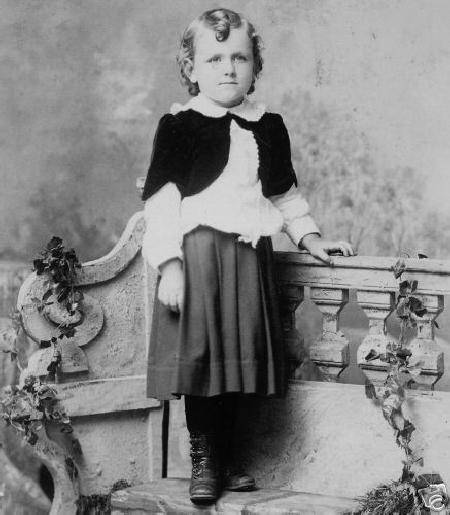
Kilt Suits: Jacket Styles

Figure 1.--This Philadelphia boy wears a cut-away jacket kilt suit. Note that the jacket and kilt skirt do not match. Also note the kilt is styled more like a skirt. We are not sure about the date. The Fauntleroy styling suggests the 1880s, but given the short jacket sleeves and the blouced blouse sleeves, we think the 1870s may be more likely. As the portrait is a cabinent card, it can not be any earlier than the mid-1860s. Note the boy's top curl.
|
|
HBC has noted several different styles of kilt skirts. The style was normally determined by the jacket. Here we see several different jacket styles. We see the standard kilt suit with long jackets. Here the jacket and kilt-skirt almost always matched. The jackets were done in various styles. There were several other jackets styles. We notice in particular sailor-styled jackets and cut-away jackets. One of the styles in which boys kilts were available was the popular sailor suit style. These had become particularly popular by the 1870s.Cut-away jacket were also popular. Some of the cut-away jackets were done with Fauntleroy styling. A related fashion to the kilt suit was the Fauntleroy kilt. This adapted the kilt suit to the imensly popular Fauntleroy suit. While the style of the suit was rather determined by the jacket, we notice different styles of skirt-kilts as well. On some suits the styling on the jacket was repeated on the kilt-skirt, but this was not always the case.
Jackets
HBC has noted several different styles of kilt skirts. The style was normally determined by the jacket. Here we see several different jacket styles.
Cut-away Jacket Kilt Suit
One of the most popular styles for younger boys beginning about the 1860s was the cut-away jacket. These were usually worn with knee pats, although long pants were still common in the 1860s. We also see may kilt suits worn with cut-away jackets, although we are not yet sure about the chronology. Fautleroy kilt suits used cut-away jackets.
Standard Kilt Suit
We see the standard kilt suit with long jackets. Here the jacket and kilt-skirt almost always matched. The jackets were done in various styles. Single breasted styling was the most common for kilt suits.
While not the most common, some kilt suit jackets were made in the double breasted style.
A related fashion to the kilt suit was the Fauntleroy kilt. This adapted the kilt suit to the imensly popular Fauntleroy suit. It was a kilt suit, but with a kilt-suit rather than knee pants. We believe some mothers after breeching continued to use the javlet, only with knee pants. The Fauntleroy kilt employed smallcut-away jacket designed to be worn open. This was to display the boy's lacy blouse to best advantage. The jacket of the Fauntleroy kilt was
generally made of velvet, often black velvet, but some were made in the
same fabric as the skirt kilt.
One of the styles in which boys kilts were available was the popular sailor suit style. These had become particularly popular by the 1870s. They were often called kilt-suits, but they were not really plaid as the skirt, almost always white or blue, usually matching the middy blouse. Proper plaid kilts were never worn with middy blouses. As a result, it was not quite accurate to refer to the skirts as kilts, but it was generally done as the term kilt was considered more appropriate for boys. One advantage of this style was that after the boy was breeched, he could continue wearing his middy blouse, simply replacing the kilt skirt with kneepants. Plaid as the skirt, almost always white or blue, usually matching the middy blouse. Proper plaid kilts were never worn with middy blouses. As a result, it was not quite accurate to refer to the skirts as kilts, but it was generally done as the term kilt was considered more appropriate for boys. One advantage of this style was that after the boy was breeched, he could continue wearing his middy blouse, simply replacing the kilt skirt with kneepants.
Blouses were worn with some kilt suits. Some kilt suits were specifically designed to be worn with blouses. Others were not. We nore fancy Fauntleroy blouses worn with some kilt suits. The most obvious were the blouses worn with cut-away jackets, at least the ones worn without vests. With many kilt suits, however, it is difficult to see the type of shirt or blouse being worn. There were some kilt suits designed to be worn with blouses without jackets--sailor blouses. We also note boys wearing blouses without jackets, especially during the summer. Hsre the boys probzblu had jackets and even vests for their kilt/skirts, but did not wear them in the warm summer weather.
Utility
Kilt suit jackets were quite utilitarian garments. They could be used for an extended period. A the time the mother thought approprariate, a pair of kneepants couold be purchased and substituted for the kilt. The boy could continue wearing the same jacket.
Kilt-Skirts
While the style of the suit was rather determined by the jacket, we notice different styles of skirt-kilts as well. On some suits the styling on the jacket was repeated on the kilt-skirt, but this was not always the case.
HBC

Navigate the Boys' Historical Clothing Web Site:
[Introduction]
[Activities]
[Biographies]
[Chronology]
[Cloth and textiles]
[Clothing styles]
[Countries]
[Topics]
[Bibliographies]
[Contributions]
[FAQs]
[Glossaries]
[Images]
[Registration]
[Tools]
[Boys' Clothing Home]
Navigate the Boys' Historical Clothing kilt pages:
[Return to the Main kilt suit page]
[Return to the Main kilt suit type page]
[Return to theMain kilt page]
[Scottish kilts]
[Scottish boys clothing]
[Scottish school uniform]
[Highland dance]
[Irish kilts]
[Irish boys clothing]
[Irish step dancing]
[Greek kilts]
Created: 3:16 AM 5/3/20071
Last updated: 3:59 AM 1/25/2008



